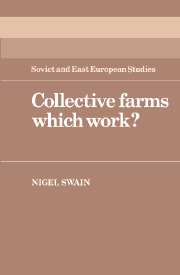Book contents
- Frontmatter
- Contents
- Preface
- Introduction
- PART I ‘FAMILY LABOUR’ AND ‘SOCIALIST WAGE LABOUR’ IN HUNGARY'S CO-OPERATIVE AGRICULTURE: THE INCORPORATION OF PETTY COMMODITY PRODUCTION
- PART II MEMBERS AND MANAGERS
- PART III MANAGERIAL CONTROL IN AGRICULTURE
- Conclusion
- Appendix I The transformation of Hungarian agriculture
- Appendix II Ancillary enterprises within agricultural co-operatives: number of units engaged in non-agricultural activity
- Notes
- References and bibliography
- Index
Conclusion
Published online by Cambridge University Press: 10 December 2009
- Frontmatter
- Contents
- Preface
- Introduction
- PART I ‘FAMILY LABOUR’ AND ‘SOCIALIST WAGE LABOUR’ IN HUNGARY'S CO-OPERATIVE AGRICULTURE: THE INCORPORATION OF PETTY COMMODITY PRODUCTION
- PART II MEMBERS AND MANAGERS
- PART III MANAGERIAL CONTROL IN AGRICULTURE
- Conclusion
- Appendix I The transformation of Hungarian agriculture
- Appendix II Ancillary enterprises within agricultural co-operatives: number of units engaged in non-agricultural activity
- Notes
- References and bibliography
- Index
Summary
This book has presented an account of Hungary's successful collectivisation of agriculture, the transformation in economic relations that this entailed, and the changes in the social composition of the agricultural labour force and management that accompanied it. In a sense, the book has been about Hungarian agricultural producer co-operatives as both a socialist success and a socialist failure: about an economic success, but a social and political failure, at least in the sense that these units have failed to create a workplace environment with intrinsically socialist features. The mechanisms which exist to promote workplace democracy do not function as such. We have seen how an agricultural sector based on collective and state production units can be made to work by devoting national resources to agriculture during the period of transition and by creating ‘socialist wage labour’ within communal production, while at the same time integrating with it an increasingly encouraged reliance on the ‘family labour’ of the work force, performed in its ‘marginal labour time’. The success of this policy of symbiosis as a more general economic strategy can be seen in its extension, in the form of the ‘economic work partnerships’ of the 1980s, from agriculture to other sectors of the economy; and it is also evident in the fact that the two areas of significant difference between Hungarian and Soviet collective farms are Hungary's active encouragement of ‘family labour’ and its ability to put a competitive price on the ‘socialist wage labour’ of the collective farm. This economic success must be of relevance to any socialist country in the developing world.
- Type
- Chapter
- Information
- Collective Farms which Work? , pp. 181 - 194Publisher: Cambridge University PressPrint publication year: 1985



